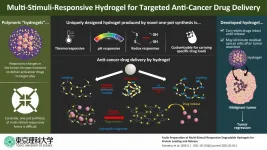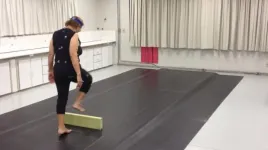Novel "hydrogel" carriers for anti-cancer drugs offer new hope for cancer treatment
Anti-cancer drug delivery to target tumor sites now becomes more effective with novel multi-stimuli-responsive drug delivery systems
2021-04-07
(Press-News.org) Cancer therapy in recent times relies on the use of several drugs derived from biological sources including different bacteria and viruses, among others. However, these bio-based drugs get easily degraded and therefore inactivated on administration into the body. Thus, effective delivery to and release of these drugs at target tumor sites are of paramount importance from the perspective of cancer therapy.
Recently, scientists have discovered unique three-dimensional, water-containing polymers, called hydrogels, as effective drug delivery systems (DDSs). Drugs loaded into these hydrogels remain relatively stable owing to the network-like structure and organic tissue-like consistency of these DDSs. Besides, drug release from hydrogels can be controlled by designing them to swell and shrink in response to certain stimuli, or minute changes in conditions, like temperature or pH (which determines the acidity of an environment). For instance, when conditions are just the right level of acidic in the tumor microenvironment, these DDSs either shrink or swell and release the drug.
However, there has been no method for the one-pot synthesis of hydrogels that respond to more than one such stimulus and degrade to release drugs at target tumor sites. Until now.
Now, a team of scientists, led by Professor Akihiko Kikuchi from Tokyo University of Science, reports the production of unique degradable hydrogels that respond to changes under multiple conditions in "reducing" environments mimicking the microenvironment of tumors. As Prof. Kikuchi observes, "In order to prepare degradable hydrogels that can release drugs in response to changes in the tumor microenvironment, we prepared hydrogels that respond to temperature, pH, and reducing environment, and analyzed their properties."
In their study published in the Journal of Controlled Release, Prof. Kikuchi--along with his colleagues from Tokyo University of Science, Dr. Syuuhei Komatsu, Ms. Moeno Tago, and Ms. Yu Ando, and his collaborator on the study, Prof. Taka-Aki Asoh from Osaka University--details the steps of designing these novel hydrogels from the synthetic polymer poly(ethylene glycol) diglycidyl ether and the sulfur-containing organic compound cystamine. In response to low temperatures, these hydrogels swell up while they shrink at the physiological temperature. Additionally, the hydrogels respond to pH changes by virtue of possessing tertiary amino groups. It must be noted here that the pH of the tumor microenvironment fluctuates between 5.5 and 6.5 owing to glycolysis in the tumor cells. Under the reducing conditions of this environment, the hydrogels degrade because of the breakage of disulfide bonds and change into low molecular-weight water-soluble oligomers that are easily excreted from the body.
To further test their drug release properties, the scientists loaded these hydrogels with specific proteins by exploiting their temperature-dependent swelling-deswelling behavior and tested the controlled release of drugs under acidic or reducing conditions. It was found that the amount of drug loaded onto these hydrogels could be controlled by changing the mesh size of the hydrogel polymer network by changing temperature, suggesting the possibility of customizing these DDSs for specific drug delivery. Besides, the hydrogel network structure and electrostatic interactions in the network ensured that the proteins were preserved intact until delivery, unaffected by the swelling and shrinking of the hydrogels with pH changes in the surrounding environment. The scientists found that the loaded protein drugs were completely released only under reducing conditions.
Using these hydrogels and the tractability that they provide, doctors may soon be able to design "customized" hydrogels that are specific to patients, giving personalized medicine a big boost. In addition to that, this new DDS provides a way to kill cancer cells that are left behind after surgery. As Prof. Kikuchi states, "The implantation of this material in the affected area after cancer resection may eliminate residual cancer cells, making it a more powerful therapeutic tool".
As cancer tightens its vise grip around the world, treatment options need to be varied and upgraded for customized and effective therapy. This unique and simple design technique to produce multi-stimuli-responsive hydrogels for effective drug delivery to target tumor sites may just be one among several such promising techniques to mount an answer to the challenge cancer poses to humanity.
INFORMATION:
About The Tokyo University of Science
Tokyo University of Science (TUS) is a well-known and respected university, and the largest science-specialized private research university in Japan, with four campuses in central Tokyo and its suburbs and in Hokkaido. Established in 1881, the university has continually contributed to Japan's development in science through inculcating the love for science in researchers, technicians, and educators.
With a mission of "Creating science and technology for the harmonious development of nature, human beings, and society", TUS has undertaken a wide range of research from basic to applied science. TUS has embraced a multidisciplinary approach to research and undertaken intensive study in some of today's most vital fields. TUS is a meritocracy where the best in science is recognized and nurtured. It is the only private university in Japan that has produced a Nobel Prize winner and the only private university in Asia to produce Nobel Prize winners within the natural sciences field.
Website: https://www.tus.ac.jp/en/mediarelations/
About Professor Akihiko Kikuchi from Tokyo University of Science
Prof. Akihiko Kikuchi is a faculty member of the Department of Materials Science and Technology, Faculty of Advanced Engineering at Tokyo University of Science, Japan. He graduated in Industrial Chemistry in 1987 from Tokyo University of Science and obtained his doctorate in Industrial Chemistry from Tokyo University of Science Graduate School in 1992. He has published various research papers in the fields of Biomedical engineering/Biomaterial science and engineering. He received Yamazaki Teiichi Prize in 2009 and the Award of Japanese Society for Biomaterials in 2018. He was elected as the Fellow of the International Union of Societies for Biomaterials Science and Engineering in 2016. He is also affiliated to Society of Polymer Science, Japan as the Vice Chair for the 70th Meeting of the Society of Polymer Science.
[Attachments] See images for this press release:

ELSE PRESS RELEASES FROM THIS DATE:
2021-04-07
By Karina Ninni | Agência FAPESP – A multidisciplinary research group affiliated with the Department of Physical Education’s Human Movement Laboratory (Movi-Lab) at São Paulo State University (UNESP) in Bauru, Brazil, measured step length synergy while crossing obstacles in patients with Parkinson’s disease and concluded that it was 53% lower than in healthy subjects of the same age and weight. Step length is one of the main variables affected by the disease.
Synergy, defined as combined operation, refers in this case to the capacity of the locomotor (or musculoskeletal) system to adapt movement while crossing an obstacle, combining factors such as speed and foot position, for example. Improving synergy in Parkinson’s patients while they ...
2021-04-07
You might not think an animal made out of stone would have much to worry about in the way of predators, and that's largely what scientists had thought about coral. Although corallivores like parrotfish and pufferfish are well known to biologists, their impact on coral growth and survival was believed to be small compared to factors like heatwaves, ocean acidification and competition from algae.
But researchers at UC Santa Barbara have found that young corals are quite vulnerable to these predators, regardless of whether a colony finds itself alone on the reef or surrounded by others of its kind. The research, led by doctoral student Kai Kopecky, appears in the journal Coral Reefs.
Kopecky and his co-authors ...
2021-04-07
Unusual diseases are medical mysteries that fascinate us, and one such disease is multiple system atrophy, or MSA. This rare neurological disorder causes failures in the proper functioning of the body's autonomic system (processes that are not under our conscious control, such as blood pressure, breathing, and involuntary movement). The resulting symptoms can look like two other types of neurodegenerative disease: Parkinson's disease and cerebellar ataxia. In fact, MSA can be separated into a parkinsonism subtype or a cerebellar subtype based on whether the resultant movement-related ...
2021-04-07
Within multicellular organisms, cells build connections with each other forming cell layers that cover the surfaces of tissues and organs and separate structures in the body. For example, the skin forms a mantle around the entire organism, and the layer of cells lining the blood vessels creates a boundary between the bloodstream and tissues. Special connections between neighbouring cells ensure that these cellular barriers are, on the one hand, stable and tight - thus protecting the body and organs against pathogens - while, on the other hand, they remain permeable to specific substances or migrating cells. This is how the cells allow dissolved ...
2021-04-07
Imagine the process of distributing electricity to homes from the power grid is like travelers boarding a train.
There are multiple steps to take before they can reach their final destination. First, they have to buy a ticket at the ticketing booth - this is where the power is generated. Then, they board a train that departs from the station - the power is transmitted over distances using transmission lines. Finally, the train takes the travelers (electricity) to their final destination. This final step of sending power to homes and businesses is called the distribution system - and it is critical that ...
2021-04-07
Today, the Muon g-2 Collaboration finally published the highly anticipated first result from its measurement of the anomalous magnetic moment of the muon, a precision quantity that offers physicists one of the most promising means to test predictions of the actual Standard Model of particle physics. The measured value, which is more precise than all values before, strengthens evidence for the emergence of new physics beyond the Standard Model, and thus for the existence of previously unknown particles or forces. The result was presented at an online ...
2021-04-07
In a new study, North Carolina State University researchers found that an outdoor science program was linked to higher average science grades and an increase in a measure of science knowledge for a group of fifth grade girls in North Carolina.
The findings, published in the International Journal of Science Education, indicates outdoor education could be a promising tool to help close gender gaps in science.
"The outdoors is a space where teachers can find tangible ways to make science come alive," said the study's lead author Kathryn Stevenson, assistant professor of parks, recreation and tourism management at NC State. "The natural environment is also a place that everybody has in common. In a way, it's also a great context for employing reform-based teaching practices ...
2021-04-07
Conspiracy theories appear to be increasing in popularity as the Covid-19 pandemic continues. But to what extent do people really agree with them, and what is the association with cognitive biases? A research team from the University of Basel studied these questions in German-speaking Switzerland and Germany.
Periods of crisis are often conducive to the emergence and spread of conspiracy theories, and the Covid-19 pandemic is a case in point. A research team led by Sarah Kuhn and Dr. Thea Zander-Schellenberg of the University of Basel has investigated the endorsement rates of coronavirus-related conspiracy theories in German-speaking Switzerland and Germany, ...
2021-04-07
Muons, particles akin to electrons, have kepts physicists' heads spinning for more than a decade, because an experimental measurement of their magnetic properties (1) disagrees with theory. Could this be caused by unknown particles or forces?
A new theoretical calculation of this parameter, involving CNRS physicists and published in the journal Nature, has reduced the discrepancy with the experimental measurement. The debate nevertheless continues.
--
For over 10 years, measurement of the magnetic properties of the muon (an ephemeral cousin of the electron) has exhibited disagreement with theoretical predictions. This ...
2021-04-07
A team of scientists, led by the University of Bristol, with archaeologists from Oxford Archaeology, have found the first evidence of a religious diet locked inside pottery fragments excavated from the early medieval Jewish community of Oxford.
Keeping kosher is one of the oldest known diets across the world and, for an observant Jew, maintaining these dietary laws (known as Kashruth) is a fundamental part of everyday life. It is a key part of what identifies them as Jews, both amongst their own communities and to the outside world.
Oxford's Jewish quarter was established around St. Aldates in the twelfth and thirteenth centuries, following William the Conqueror's invitation ...
LAST 30 PRESS RELEASES:
[Press-News.org] Novel "hydrogel" carriers for anti-cancer drugs offer new hope for cancer treatment
Anti-cancer drug delivery to target tumor sites now becomes more effective with novel multi-stimuli-responsive drug delivery systems





